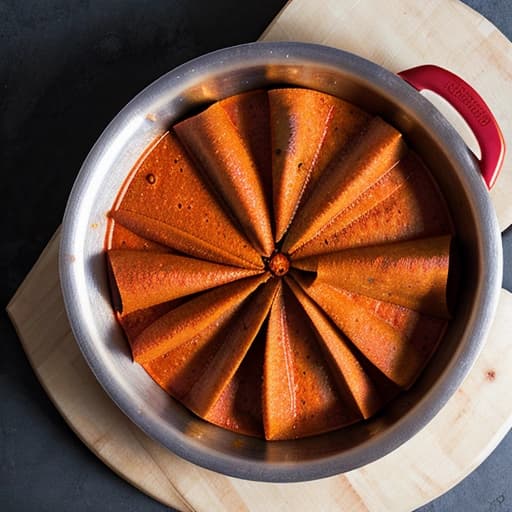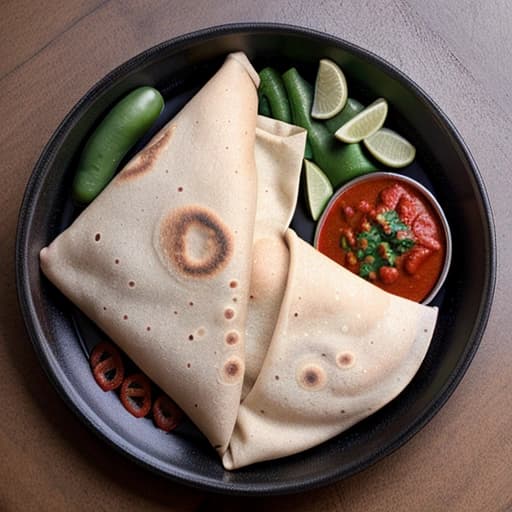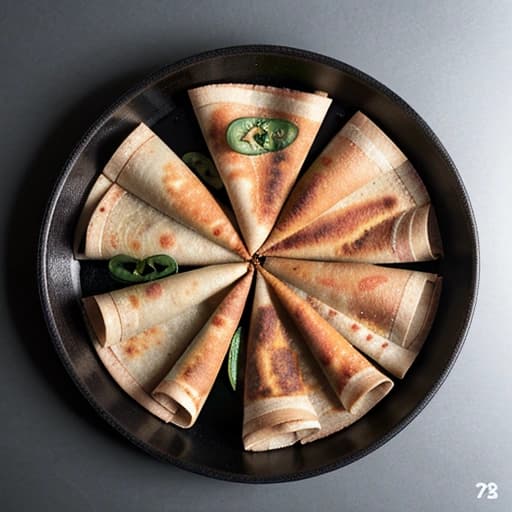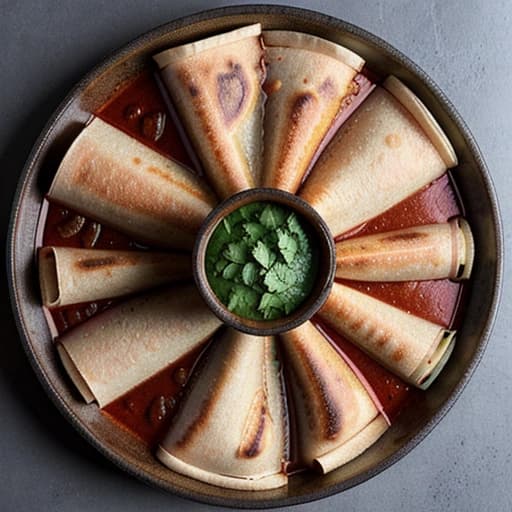Vegetable Masala Dosa
A popular South Indian dish made with a fermented rice and lentil crepe, stuffed with a flavorful vegetable and spice mixture.






4.3 / 5 (684)
Ingredients
Dosa Batter
- rice
2 cups
- urad dal
1 cup
- fenugreek seeds
a pinch
Filling
- potato
2 medium-sized
- carrot
1 medium-sized
- peas
1 cup
- onion
1 medium-sized
- ginger
1 inch
- curry leaves
a few leaves
Instructions
- 1
Soak the rice, urad dal, and fenugreek seeds for 4-5 hours, then grind into a smooth batter with water.
Start by soaking the rice, urad dal, and fenugreek seeds in separate containers for 4-5 hours. After soaking, grind the rice and urad dal into a smooth batter using a wet grinder or blender, adding water as needed. The batter should be free of lumps and have a consistency similar to pancake batter. Add the fenugreek seeds to the batter and mix well.
- 2
Ferment the batter for 8-10 hours or overnight.
Transfer the batter to a large bowl, cover it with a lid, and let it ferment in a warm place for 8-10 hours or overnight. The fermentation process will help the batter rise and give the dosa its characteristic texture and flavor.
- 3
Prepare the filling by boiling the potato, carrot, and peas until they are tender, then mash the potato and mix with the other ingredients.
To prepare the filling, start by boiling the potato, carrot, and peas in a large pot of water until they are tender. Drain the water and let the vegetables cool. Once cooled, peel the potato and mash it in a bowl. Add the cooked carrot and peas to the bowl, along with the chopped onion, ginger, and curry leaves. Mix everything together until well combined. Season with salt to taste.
- 4
Heat a non-stick pan or dosa tava over medium heat, then pour a small amount of the fermented batter onto the pan and spread it evenly to form a thin crepe.
To cook the dosa, heat a non-stick pan or dosa tava over medium heat. Once the pan is hot, pour a small amount of the fermented batter onto the pan, just enough to cover the surface. Use a spatula or the back of a spoon to spread the batter evenly and form a thin crepe. Make sure to spread the batter in a circular motion, starting from the center and working your way outwards.
- 5
Place a tablespoon or two of the prepared filling in the center of the crepe, then fold the crepe over the filling to form a masala dosa.
Once the crepe is cooked and the surface is dry, place a tablespoon or two of the prepared filling in the center of the crepe. Use a spatula to fold the crepe over the filling, starting with the sides and then rolling it over to form a masala dosa. Make sure to fold the crepe gently but firmly, so that the filling is secure and the crepe does not tear.
Ratings & Reviews
User Ratings
5
363
4
218
3
60
2
38
1
5
Reviews
 LeyLey87
LeyLey87I try Vegetable Masala Dosa recipe. It is very interisting dish from South India. I like that it have many vegetable in it. But, I think it miss some special spice. Maybe some saffron or sumac can make it more delicious. Also, I wish there was a halal version of this recipe. I like dosa, but I need to be sure that all ingredients are halal. Overall, it is good dish, but not my favorite. I prefer traditional Persian food like saffron-infused rice or kebabs.
 SofiaSolves
SofiaSolvesI must commend the creator of this Vegetable Masala Dosa recipe for its intricate details and well-structured steps. As a health-conscious vegetarian with a gluten intolerance, I appreciate that this dish is naturally free from gluten and packed with nutritious ingredients like rice, lentils, and vegetables. The fermentation process involved in making the dosa batter is quite fascinating, and I'm eager to try it out. However, I do wish there were some suggestions for gluten-free alternatives or modifications to accommodate my dietary needs. Perhaps substituting the traditional dosa batter with a gluten-free version or providing a note on gluten-free dosa recipes would be helpful. Overall, I'm excited to give this recipe a try and explore the flavors of South India in a healthy and delicious way.
 Nalani_NZ
Nalani_NZ### A Deliciously Complex Canvas: Vegetable Masala Dosa Review ### As someone who revels in the beauty of fusion cuisine, I found the Vegetable Masala Dosa recipe to be a fascinating blend of traditional South Indian flavors with a versatility that screams for innovation. This dish, with its fermented rice and lentil crepe stuffed with a vibrant vegetable and spice mixture, is not just a meal; it's an experience. The process of creating this dosa is, in itself, a journey. The fermentation of the batter, the patience required, and the gentle art of crafting each crepe all speak to a culinary tradition that values mindfulness and connection with the food we eat. For a creative soul like mine, this process is meditative and fulfilling. However, being lactose intolerant, I appreciated that this recipe doesn't include any dairy products, making it a welcoming option for those with similar dietary restrictions. The use of rice, urad dal, and fenugreek seeds not only caters to gluten-free requirements but also offers a fascinating exploration of textures and tastes. The real magic happens when you take that first bite. The crunch of the dosa giving way to the soft, spiced filling is a sensory delight. While the recipe sticks to traditional ingredients, I couldn't help but imagine the exciting possibilities of adding a Kiwi twist – perhaps with some locally-sourced vegetables or a hint of New Zealand's distinct herbs. In essence, the Vegetable Masala Dosa is more than just a recipe; it's a canvas waiting for your personal touch. It's about embracing diversity in the kitchen, experimenting with flavors, and celebrating the inclusivity of food that brings people together. **In short, this recipe earns a solid 4 stars from me.** It's a dish that not only respects its roots but also invites creativity and exploration. Whether you're a seasoned chef or a curious cook, this dosa recipe promises a delicious journey that's as rewarding as it is flavorful.
 SofiRdz21
SofiRdz21Honestly, I'm low-key obsessed with dosas, and this Vegetable Masala Dosa recipe did not disappoint 🙌! As a pescatarian who's all about fresh veggies and seafood, I was stoked to see the emphasis on plant-based goodness 🌟. The fermentation process was a bit of a pain, but trust me, it was worth it - that tangy flavor is 🔥! I did wish there was a seafood option, but I'm not mad at the veggie-filled goodness 🥗. The only thing that would've made it better is if it had a Mediterranean twist, like some feta or olives 🧀. Also, super important note: no peanuts in sight, which is a total win for me 🤯. Overall, I'm giving this recipe 4 stars - would've been 5 if it had some seafood love 🐟 or a Mediterranean vibe 🌊. Highly recommend for a creative and delicious meal, though! 👍
 Sofiarg21
Sofiarg21¡Hola! I was really excited to try this Vegetable Masala Dosa recipe, and I'm glad I did. As a vegetarian who loves traditional dishes from other cultures, I appreciated the unique blend of flavors and textures in this South Indian crepe. The fermentation process was a bit of a challenge, but it was worth it for the tangy taste and airy texture. I loved that the recipe used locally-sourced ingredients like rice, lentils, and vegetables, which aligns with my passion for food sustainability. However, I did wish there were more suggestions for reducing waste in the kitchen. Maybe some ideas for using leftover batter or vegetable scraps? Overall, I'd definitely make this again and experiment with different fillings. ¡Buen provecho!
 majka91
majka91Cześć! I was excited to try this Vegetable Masala Dosa recipe, but unfortunately, it didn't quite fit my vegan lifestyle. The recipe calls for urad dal, which is a type of lentil that is often not vegan due to the processing methods. However, I assume it can be replaced with a vegan alternative. I also appreciate that the recipe uses plant-based ingredients like vegetables and rice. The preparation process seemed a bit lengthy, but I love trying new types of cuisine, especially if they're from different parts of the world. If I were to make this recipe, I would definitely substitute some ingredients to make it vegan-friendly. Maybe I'll try using a different type of lentil or bean. Overall, it was an interesting recipe, but I wouldn't make it again without some modifications. Także, I wish there were more vegan options out there that cater to people with sesame allergies like myself.
 KTNR89
KTNR89I try dis recipe, Vegetable Masala Dosa, and it is okay, but not my favorite, you know? As a big meat lover, I miss da protein in dis dish. Dosa itself, it is like crepe, nice and thin, but filling, it is too...vegetable, haha. I like Japanese ramen, BBQ, give me something with meat, and I am happy. This dosa, it is good for vegetarians, I think. I have to admit, I struggle with some words while cooking, like 'fenugreek', what is dis? But recipe, it is not too hard, and dosa, it is tasty, just not my cup of tea. Maybe I try with some chicken or beef next time, make it more interesting for me.
 MattGarcia22
MattGarcia22Yaaas, I gotta say, this veggie masala dosa recipe is 🔥! I mean, I was a bit skeptical at first, I've never made anything like it b4, but it turned out pretty cool. The fermentation process was kinda like making sourdough, but with a diff twist. And the filling? So flavorful! I was worried about the nut allergy, but there's no nuts in sight, so that's a big plus. My only gripe is that it took a bit longer than expected to make, like, an hour or so. But trust me, it's worth it. I'd def make it again, maybe with some spicy salsa on the side 🍴👌
 MiguelAR85
MiguelAR85### A Respectful Try at Vegetable Masala Dosa I approached this Vegetable Masala Dosa recipe with an open mind and a bit of curiosity. As someone who usually sticks to traditional Latin American cuisine, I was eager to try something new and learn about the cultural significance of this South Indian dish. While I appreciate the effort that goes into making a dosa from scratch, I have to admit that the flavors didn't quite resonate with my taste buds. The dish was a bit too... adventurous for my liking, with too many ingredients and textures competing for attention. I think I would have enjoyed it more if the flavors were a bit milder and more balanced. That being said, I do appreciate the complexity and tradition behind this recipe, and I can see why it's a beloved dish for many. **Pros:** - The recipe provides a great introduction to South Indian cuisine and the process of making dosas from scratch. - The filling ingredients were well-cooked and added a nice variety of textures. **Cons:** - The flavors were a bit too bold and spicy for my taste. - The preparation time was a bit longer than I expected, which might be a drawback for some. Overall, I would recommend this recipe to those who are looking to try something new and are fans of South Indian cuisine. For me, however, I think I'll stick to my Latin American favorites for now.